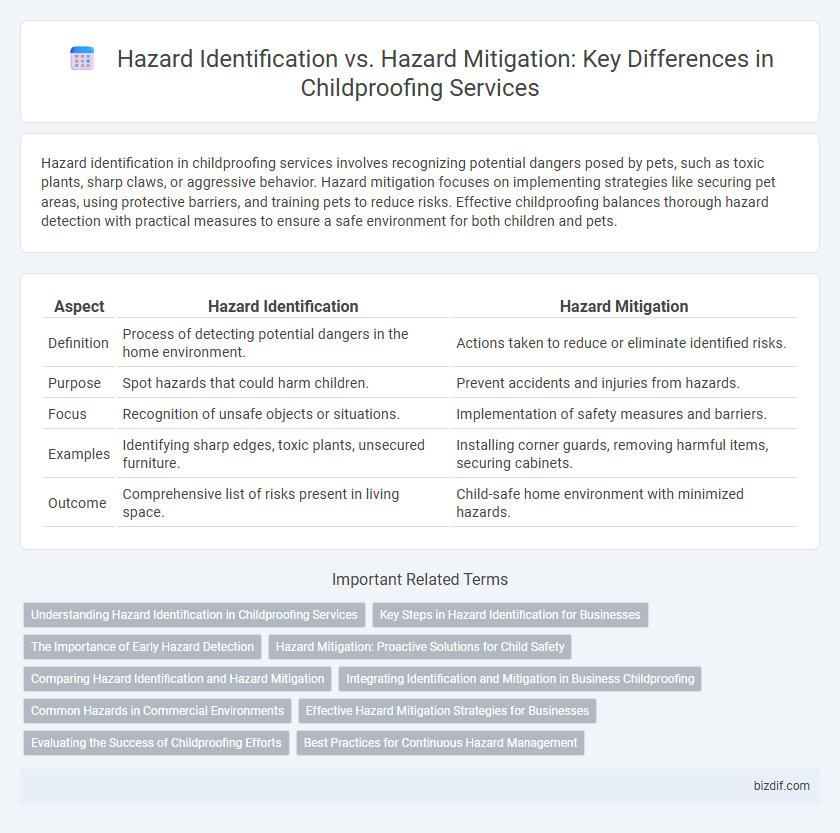Hazard identification in childproofing services involves recognizing potential dangers posed by pets, such as toxic plants, sharp claws, or aggressive behavior. Hazard mitigation focuses on implementing strategies like securing pet areas, using protective barriers, and training pets to reduce risks. Effective childproofing balances thorough hazard detection with practical measures to ensure a safe environment for both children and pets.
Table of Comparison
| Aspect | Hazard Identification | Hazard Mitigation |
|---|---|---|
| Definition | Process of detecting potential dangers in the home environment. | Actions taken to reduce or eliminate identified risks. |
| Purpose | Spot hazards that could harm children. | Prevent accidents and injuries from hazards. |
| Focus | Recognition of unsafe objects or situations. | Implementation of safety measures and barriers. |
| Examples | Identifying sharp edges, toxic plants, unsecured furniture. | Installing corner guards, removing harmful items, securing cabinets. |
| Outcome | Comprehensive list of risks present in living space. | Child-safe home environment with minimized hazards. |
Understanding Hazard Identification in Childproofing Services
Hazard identification in childproofing services involves recognizing potential dangers in a home environment that could harm children, such as sharp edges, toxic substances, or electrical outlets. This process is crucial for creating a safe space by systematically assessing every room for risks that require attention. Understanding hazard identification allows professionals to target specific threats before implementing effective hazard mitigation measures to protect children from injuries.
Key Steps in Hazard Identification for Businesses
Key steps in hazard identification for businesses include conducting thorough inspections of the premises to detect potential safety risks, analyzing workplace processes to uncover unseen hazards, and consulting with employees to gather insights on everyday dangers. Utilizing checklists and risk assessment tools ensures systematic evaluation and documentation of identified hazards. Implementing continuous monitoring and periodic reviews maintains up-to-date awareness of emerging threats to child safety.
The Importance of Early Hazard Detection
Early hazard detection plays a crucial role in childproofing services by identifying potential dangers before accidents occur. Hazard identification involves a thorough assessment of the environment to spot risks such as sharp edges, toxic substances, and choking hazards. Effective hazard mitigation follows by implementing safety measures like securing cabinets, covering outlets, and installing safety gates to prevent injuries and ensure a safe space for children.
Hazard Mitigation: Proactive Solutions for Child Safety
Hazard mitigation in childproofing involves implementing proactive solutions such as installing safety gates, outlet covers, and cabinet locks to prevent potential injuries before they occur. Unlike hazard identification, which focuses on spotting risks, mitigation emphasizes taking concrete steps to eliminate or reduce dangers within a child's environment. Effective child safety strategies rely heavily on these preventative measures to create a secure home atmosphere.
Comparing Hazard Identification and Hazard Mitigation
Hazard identification involves recognizing potential safety risks within a home, such as sharp edges, choking hazards, or exposed electrical outlets, to prevent child injuries. Hazard mitigation focuses on implementing practical solutions like installing safety gates, outlet covers, and corner protectors to eliminate or reduce these identified dangers. Comparing the two, hazard identification is the essential diagnostic step, while hazard mitigation represents the actionable intervention phase to ensure a secure environment for children.
Integrating Identification and Mitigation in Business Childproofing
Effective childproofing businesses integrate hazard identification with hazard mitigation to ensure comprehensive safety solutions. Precise identification of risks, such as sharp edges, toxic substances, and unstable furniture, enables targeted mitigation strategies like corner guards, secure storage, and anchoring systems. This integration enhances credibility, minimizes liability, and delivers customized child safety services tailored to each client's environment.
Common Hazards in Commercial Environments
Hazard identification in commercial environments involves recognizing common risks such as sharp corners, electrical outlets, and slippery floors that pose threats to children. Hazard mitigation implements safety measures like installing corner guards, outlet covers, and non-slip mats to minimize accidents. Effective childproofing requires a thorough assessment followed by targeted interventions to ensure a secure space.
Effective Hazard Mitigation Strategies for Businesses
Effective hazard mitigation strategies for businesses begin with comprehensive hazard identification to pinpoint potential risks that could harm children in the environment. Implementing targeted safety measures such as secure locks, corner guards, and non-toxic materials reduces exposure to identified dangers, ensuring a safer space. Regular inspections and staff training reinforce these mitigation efforts, maintaining a consistently childproof environment that minimizes accidents.
Evaluating the Success of Childproofing Efforts
Evaluating the success of childproofing efforts involves comparing hazard identification with hazard mitigation outcomes to ensure all potential risks are addressed effectively. Hazard identification pinpoints specific dangers, while hazard mitigation measures reduce or eliminate these risks, creating a safer environment for children. Monitoring changes in incident rates and conducting regular safety audits provide critical data to assess the effectiveness of implemented childproofing strategies.
Best Practices for Continuous Hazard Management
Hazard identification involves systematically recognizing potential risks in the home environment that could harm children, such as sharp edges, toxic substances, and unsecured furniture. Hazard mitigation focuses on implementing targeted safety measures like installing corner guards, locking cabinets, and anchoring heavy items to reduce or eliminate these dangers. Best practices for continuous hazard management include routine inspections, updating safety equipment, and educating caregivers to ensure evolving risks are consistently addressed.
Hazard identification vs Hazard mitigation Infographic

 bizdif.com
bizdif.com